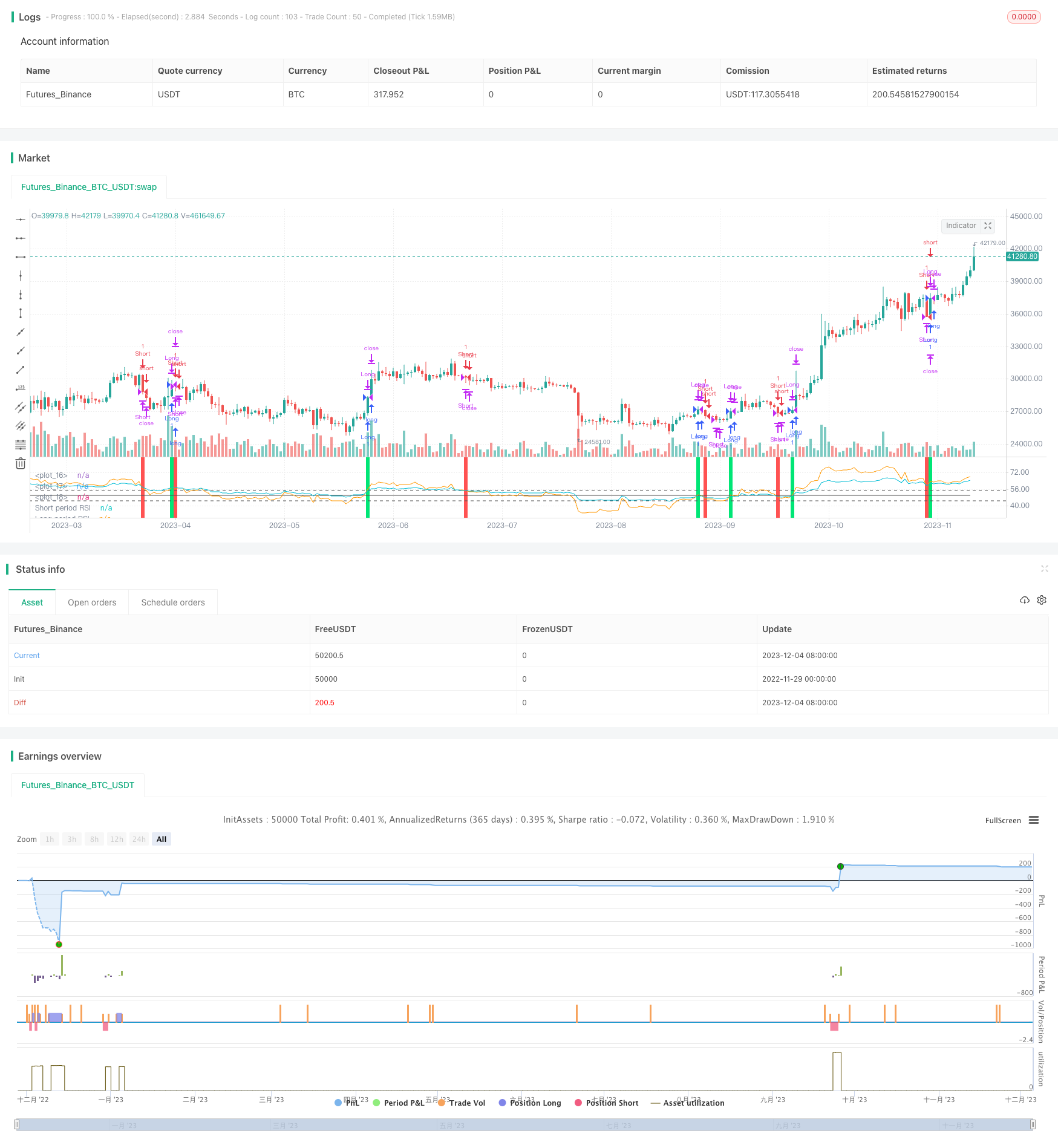
概述
本策略名称为“双时间轴RSI反转”,它是一个基于相对强度指数(RSI)的量化交易策略。该策略运用两个不同周期的RSI作为买入和卖出信号,实现低买高卖,获取股票价格反转带来的交易机会。
策略原理
该策略使用快速周期(默认55天)RSI和慢速周期(默认126天)RSI构建交易信号。当快速周期RSI上穿慢速周期RSI时生成买入信号,反之当快速周期RSI下穿慢速周期RSI时生成卖出信号。这样通过比较两个不同时间区间内价格动量的相对强弱,发现短期和长期趋势反转机会。
进入信号后,策略会设置止盈止损点。止盈点默认为进入价格的0.9倍,止损点默认为进入价格的3%。同时当重新出现反向信号时,也会平掉当前头寸。
策略优势
- 利用双RSI比较发现短期和长期价格趋势的变化点,捕捉反转机会
- 双RSI滤除假突破带来的噪音交易
- 配置止盈止损点,可以限制单笔损失
策略风险
- 股价剧烈波动期间,RSI信号可能频繁反转
- 止损点过小,可能导致小幅震荡后就止损
- 双RSI参数设置不当,可能错过大的反转趋势
策略优化
- RSI参数可以测试更多组合,找到最佳参数
- 可以结合其他指标过滤假突破信号
- 动态调整止盈止损比例,让止盈更加灵活
总结
本策略“双时间轴RSI反转”通过比较快速周期和慢速周期两个RSI的交叉作为交易信号,目标捕捉短期价格反转机会。同时设置止盈止损规则规避风险。这是一种典型的利用指标多时间轴比较实现价格反转交易的策略。优化空间在于参数调整和风控规则优化。
策略源码
/*backtest
start: 2022-11-29 00:00:00
end: 2023-12-05 00:00:00
period: 1d
basePeriod: 1h
exchanges: [{"eid":"Futures_Binance","currency":"BTC_USDT"}]
*/
//@version=2
strategy(title="Relative Strength Index", shorttitle="RSI")
slen = input(55, title="Short length")
llen = input(126, title="Long length")
sup = ema(max(change(close), 0), slen)
sdown = ema(-min(change(close), 0), slen)
rsi1 = sdown == 0 ? 100 : sup == 0 ? 0 : 100 - (100 / (1 + sup / sdown))
lup = ema(max(change(close), 0), llen)
ldown = ema(-min(change(close), 0), llen)
rsi2 = ldown == 0 ? 100 : lup == 0 ? 0 : 100 - (100 / (1 + lup / ldown))
ob = input(55, title="Overbought")
os = input(45, title="Oversold")
tp = input(.9, title="Take profit level %")*.01
sl = input(3, title="Stoploss level %")*.01
mid = avg(ob,os)
plot (mid, color=#4f4f4f, transp=0)
hline (ob, color=#4f4f4f)
hline (os, color=#4f4f4f)
long = crossover(rsi1,rsi2)
short = crossunder(rsi1,rsi2)
vall = valuewhen(long,close,0)
lexit1 = high>=(vall*tp)+vall
lexit2 = low<=vall-(vall*sl)
vals = valuewhen(short,close,0)
sexit1 = low<=vals - (vals*tp)
sexit2 = high>=vals + (vals*sl)
bgcolor (color=long?lime:na,transp=50)
bgcolor (color=short?red:na, transp=50)
strategy.entry("Long", strategy.long, when=long)
strategy.close("Long", when=lexit1)
strategy.close("Long", when=lexit2)
strategy.close("Long", when=short)
strategy.entry("Short", strategy.short, when=short)
strategy.close("Short", when=sexit1)
strategy.close("Short", when=sexit2)
strategy.close("Short", when=long)
plot (rsi1, color=orange, transp=0,linewidth=1, title="Short period RSI")
plot (rsi2, color=aqua , transp=0,linewidth=1, title="Long period RSI")